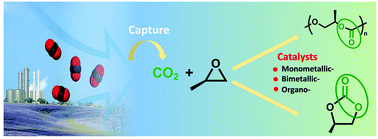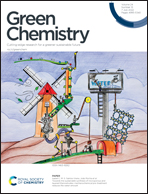Progress in the catalytic reactions of CO2 and epoxides to selectively provide cyclic or polymeric carbonates
Abstract
Sustainability requires that we reuse spent carbon sources from CO2 emissions to generate new products and materials. In this regard, carbon capture is a necessary requirement for avoiding disastrous climate changes. Hence, accompanying carbon capture technology is the need for developing low-energy processes for carbon dioxide utilization. The coupling of three-membered cycle ethers, aka oxiranes or epoxides, with carbon dioxide to provide useful cyclic carbonates or polymeric materials represents a viable approach to aid in addressing this issue. This results from the recalcitrant nature of CO2 being overcome by the energy released during the epoxide ring opening process, ∼114 kJ mol−1. Noteworthy, in this instance carbon dioxide does not undergo reduction. Consideration of the origin of the epoxide is also of importance as epoxides derived from renewable resources can be beneficial to a sustainable process. Consistent with the concept of being Green, it is also of value that the catalysis employed in these transformations be biocompatible, especially for the production of materials used in biomedical science. In this review we wish to present recent developments in the catalytic chemistry for coupling of carbon dioxide and epoxides to afford either cyclic or polymeric carbonates. Focus will be centered on new metal catalysis, especially for sequential addition of mixtures of monomers, and the use of organocatalysts for carrying out these chemical conversions.

- This article is part of the themed collections: Green Chemistry Reviews and 2022 Green Chemistry Hot Articles


 Please wait while we load your content...
Please wait while we load your content...